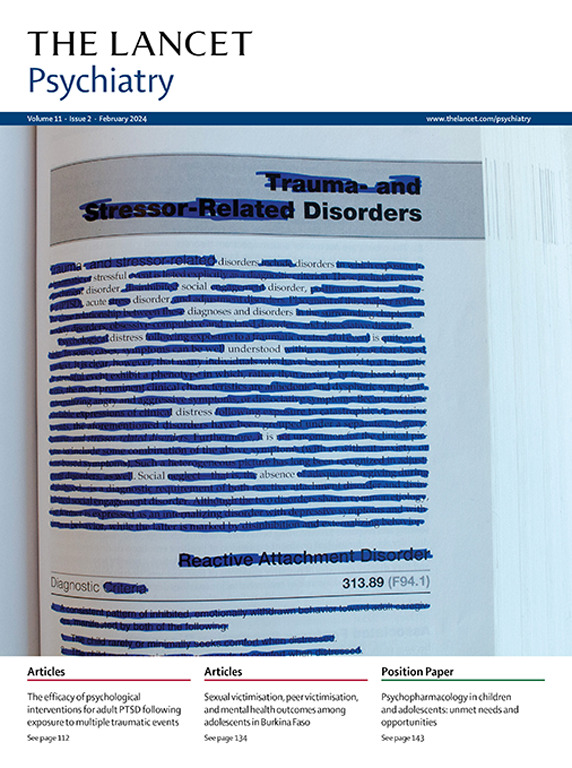跟踪整个青春期抑郁和焦虑症状的过程(CATS研究):澳大利亚一项基于人群的队列研究
IF 30.8
1区 医学
Q1 PSYCHIATRY
引用次数: 0
摘要
青少年心理健康似乎处于危机之中,但很少有研究全面描绘了常见精神障碍(CMDs;抑郁和焦虑)贯穿这个关键的人生阶段。我们的目的是通过总结年度患病率,累积发病率,抑郁和焦虑的病程,单独的和共病的CMD,在当代澳大利亚队列中按出生性别划分,来描述青春期CMD症状的过程。方法采用分层抽样方法,于2012年在澳大利亚墨尔本市建立了具有代表性的青少年过渡研究(CATS),共招募了43所学校的2289名8-9岁的学生。1239名(54.1%)学生获得家长书面知情同意,2012年至2019年每年随访10次。目前的研究使用了3-10期(10 - 18岁)的数据,并对其进行了分析,以描述青春期CMDs的症状过程。主要感兴趣的测量是临床相关的抑郁症状,临床相关的焦虑症状,以及任何CMD(临床相关的抑郁或焦虑症状)在波3-10。另一个重要的测量指标是第3-10波的共病CMDs(同时报告临床显著的焦虑和抑郁症状)。过去两周的抑郁症状是自我报告的,每一波使用13项经验证的短期情绪和感觉问卷(SMFQ),阈值得分为12或更高,表明临床相关症状。过去两周的焦虑症状是用斯宾塞儿童焦虑量表(SCAS)的8项缩短版自我报告的,每一波的阈值得分为11或更高,表明有临床相关症状。用年度患病率、抑郁和焦虑的累计发病率分别和合并来描述慢性疾病的病程。缺失数据通过多次插值处理。一位有生活经验的作者参与了研究和写作过程。结果1239名青少年中,女性667人(53.8%),男性572人(46.2%)。1239人中有769人(61%)被归类为社会经济优势,1016人中有675人(66.4%)的母亲的最高教育水平是职业或高等教育,819名参与者中有579人(77%)的种族数据被确定为盎格鲁-凯尔特人或欧洲人。总体而言,青春期任何临床显著CMD症状的发生率为74% (95% CI 70-77;女性84%[81-88],男性61%[55-66])。独立地,临床显著抑郁症状和焦虑症状的发生率分别为65%(62-68)和58%(55-62)。合并CMD的发生率为48%(45-52)。对于抑郁和焦虑症状,男女首次报告的青少年估计平均年龄分别为14.1岁(95% CI 13.9 - 14.4)和13.6岁(3.3 - 13.9)。在那些在10到18岁之间达到任何CMD阈值的人中,超过一半的人有慢性(三波或更多)病程(抑郁症54% [49-60];焦虑52%[47-58]),三分之一在随后的任何一波中都符合完全缓解的标准(抑郁症30% [25-35];焦虑33%[27-39])。与男性相比,女性一直被认为有更糟糕的青少年CMDs病程(例如,64%[58-70]的女性有慢性抑郁症状病程,而男性为37%[26-48])。在这项当代多波队列研究中,几乎四分之三的青少年报告了CMD症状。慢性CMD症状(即复发)的可能性很高。迫切需要采取普遍应对措施来解决这一重大的公共卫生问题。澳大利亚国家卫生和医学研究委员会和皇家儿童医院基金会。本文章由计算机程序翻译,如有差异,请以英文原文为准。
Tracking the course of depressive and anxiety symptoms across adolescence (the CATS study): a population-based cohort study in Australia
Background
Adolescent mental health appears to be in crisis, yet few studies have comprehensively charted the course of common mental disorders (CMDs; depression and anxiety) across this key life stage. We aimed to describe the course of CMD symptoms in adolescence by summarising annual prevalence, cumulative incidence, and course for depression and anxiety, both separately and as comorbid CMDs, by sex assigned at birth in a contemporary Australian cohort.Methods
The Child to Adult Transition Study (CATS) was established in 2012 to form a representative cohort of adolescents in Melbourne, VIC, Australia. 43 schools were recruited using a stratified sampling approach, and all 2289 students aged 8–9 years were invited to participate. 1239 (54·1%) students obtained parental written informed consent and were followed up annually from 2012 to 2019 for a total of ten waves. Data from waves 3–10 (ages 10 to 18 years) were used for the current study and analysed to describe the course of symptoms of CMDs across adolescence. Primary measures of interest were clinically relevant depressive symptoms, clinically relevant anxiety symptoms, and any CMD (clinically relevant depressive or anxiety symptoms) at waves 3–10. A secondary measure of interest was comorbid CMDs (concurrent reporting of clinically significant anxiety and depressive symptoms) at waves 3–10. Depressive symptoms in the past 2 weeks were self-reported using the 13-item validated Short Mood and Feelings Questionnaire (SMFQ) at each wave, with a threshold score of 12 or more indicating clinically relevant symptoms. Anxiety symptoms in the past two weeks were self-reported using an 8-item shortened version of the Spence Children's Anxiety Scale (SCAS) at each wave, with a threshold score of 11 or higher indicating clinically relevant symptoms. The course of CMDs was described using annual prevalence, cumulative incidence for depression and anxiety, separately and combined. Missing data were handled via multiple imputation. An author with lived experience was involved in the research and writing process.Findings
Of the 1239 adolescents who participated in the study, 667 (53·8%) were female and 572 (46·2%) were male. 769 (62·1%) of 1239 were classified as socioeconomically advantaged, 675 (66·4%) of the 1016 with available data had a mother whose highest level of education was vocational or tertiary, and 579 (70·7%) of the 819 participants with ethnicity data identified as Anglo-Celtic or European. Overall, incidence of any clinically significant CMD symptoms during adolescence was 74% (95% CI 70–77; 84% [81–88] for females and 61% [55–66] for males). Independently, incidences of clinically significant depressive symptoms and anxiety symptoms were 65% (62–68) and 58% (55–62), respectively. Incidence of comorbid CMD was 48% (45–52). The estimated mean ages of first report in adolescence for both sexes were 14·1 years (95% CI 13·9–14·4) and 13·6 years (3·3–13·9) for depressive and anxiety symptoms, respectively. Of those who reached the threshold score for any CMD between ages 10 and 18 years, over half had a chronic (three or more waves) course (depression 54% [49–60]; anxiety 52% [47–58]), and a third met criteria for full remission at any subsequent wave (depression 30% [25–35]; anxiety 33% [27–39]). Females were consistently estimated to have a worse course of adolescent CMDs compared with males (eg, 64% [58–70] of females had a chronic course of depressive symptoms vs 37% [26–48] of males).Interpretation
In this contemporary multi-wave cohort study, almost three-quarters of adolescents reported CMD symptoms. The likelihood of chronicity of CMD symptoms (ie, recurrence) was high. Universal responses are urgently required to address this considerable public health problem.Funding
National Health and Medical Research Council of Australia and the Royal Children's Hospital Foundation.求助全文
通过发布文献求助,成功后即可免费获取论文全文。
去求助
来源期刊

Lancet Psychiatry
PSYCHIATRY-
CiteScore
58.30
自引率
0.90%
发文量
0
期刊介绍:
The Lancet Psychiatry is a globally renowned and trusted resource for groundbreaking research in the field of psychiatry. We specialize in publishing original studies that contribute to transforming and shedding light on important aspects of psychiatric practice. Our comprehensive coverage extends to diverse topics including psychopharmacology, psychotherapy, and psychosocial approaches that address psychiatric disorders throughout the lifespan. We aim to channel innovative treatments and examine the biological research that forms the foundation of such advancements. Our journal also explores novel service delivery methods and promotes fresh perspectives on mental illness, emphasizing the significant contributions of social psychiatry.
 求助内容:
求助内容: 应助结果提醒方式:
应助结果提醒方式:


